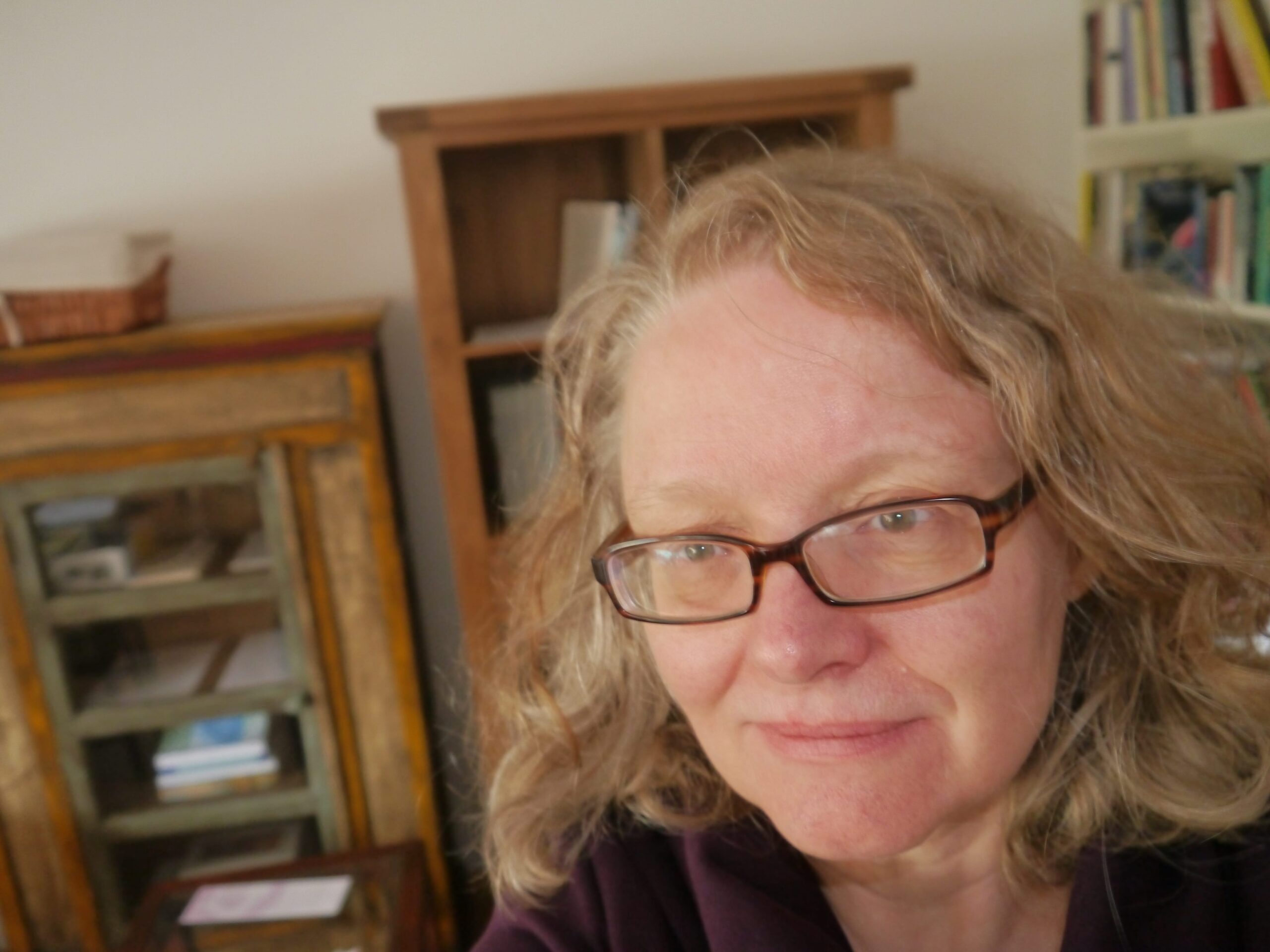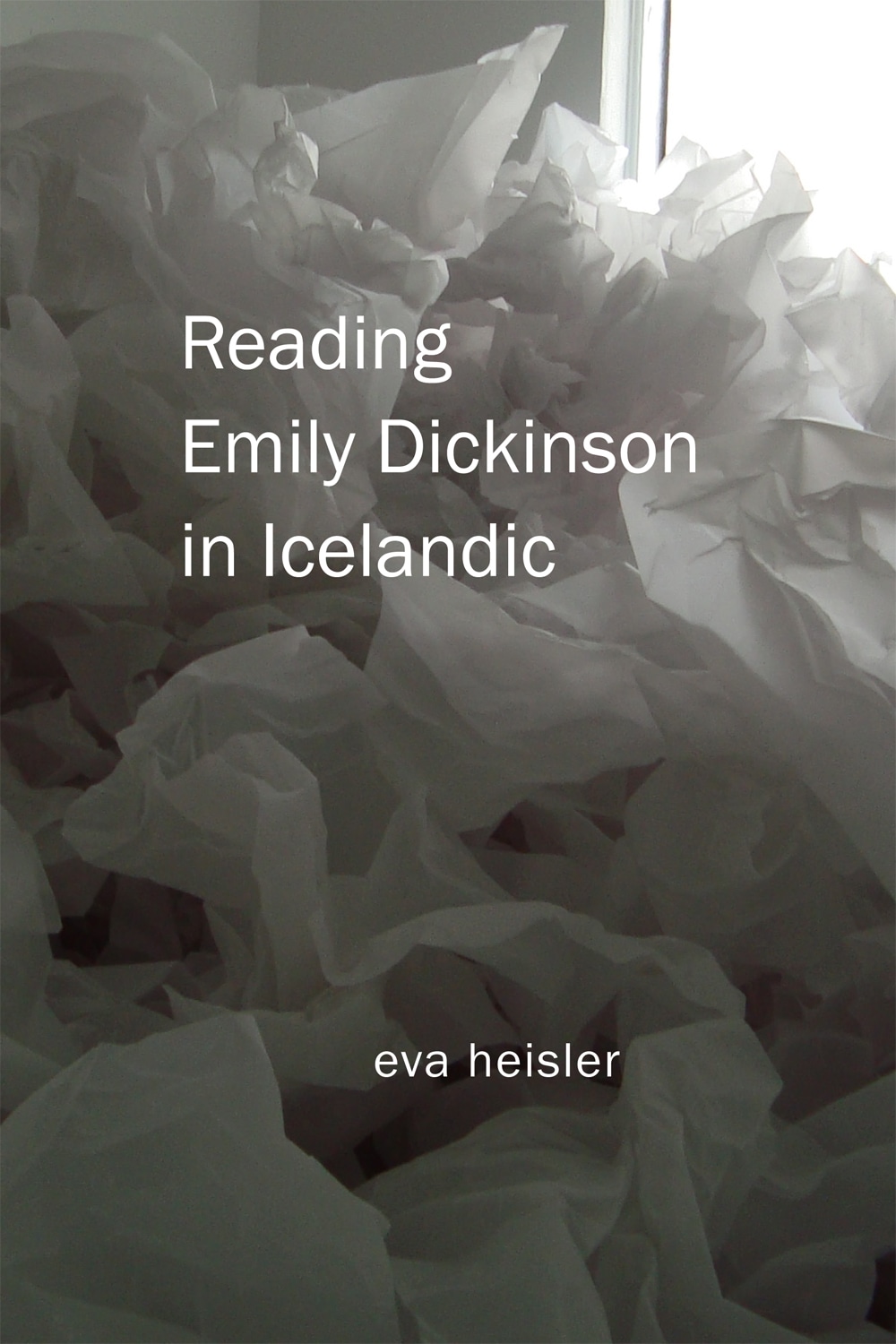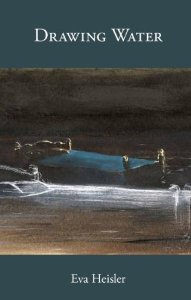Eva Heisler
 Interviewed by Carol Guess
Interviewed by Carol Guess
Eva Heisler is a Maryland-born poet and art critic who currently lives in Germany. Her poems have been widely published in journals including Crazyhorse, Poetry Northwest, and BOMB. Honors include The Nation’s “Discovery” Award and the Poetry Society of America’s Emily Dickinson Award. A Fulbright grant brought her to Iceland in 1997 where she lived for nine years, researching Icelandic art and drafting the poems in Reading Emily Dickinson in Icelandic (Kore Press, 2013). Recent publications include the book-length poem Drawing Water (Noctuary Press, 2013) and the catalog essay for Katrin Sigurdardottir: Foundation, Iceland’s Pavilion at the 2013 Venice Biennale. Samples of her work can be seen below.
Carol Guess is the author of thirteen books of poetry and prose. She teaches at Western Washington University. Follow her here at: www.carolguess.blogspot.com.
 Carol Guess: The two sections of your book feel distinct, yet complimentary. Section one, “Reading Emily Dickinson In Icelandic,” feels like a fractured novel, complete with characters and a narrative arc. “Larceny – Legacy” feels like a map of section one, describing literary influences that prepare the narrator for the linguistic puzzles she encounters in Iceland. Can you describe the process of ordering the book?
Carol Guess: The two sections of your book feel distinct, yet complimentary. Section one, “Reading Emily Dickinson In Icelandic,” feels like a fractured novel, complete with characters and a narrative arc. “Larceny – Legacy” feels like a map of section one, describing literary influences that prepare the narrator for the linguistic puzzles she encounters in Iceland. Can you describe the process of ordering the book?
Eva Heisler: The first fifty pages (the title sequence “Reading Emily Dickinson in Icelandic”) moves from a romantic view of Iceland, as seen through the eyes of an enchanted visitor, to the experience of a disgruntled resident. Central to this trajectory is the Icelandic language. At the beginning, the narrator sees so much—drinks it all in—but gradually she realizes how little she sees (in part because of how poorly she speaks) and she must face just how deeply language shapes perception.
While the sequence emerges out of my experience living for nine years in Iceland, “Reading Emily Dickinson in Icelandic” is not autobiographical; individual poems quite intentionally depart into a realm of fantasy and I play in different discourse worlds (travel narrative, guidebooks, language instruction, romance, and medieval saga).
While it’s tempting to read the first half of the book (“Reading Emily Dickinson in Icelandic”) as a memoir, the second half of the book (“Larceny – Legacy”) should throw into question the temptation to read my work as autobiographical. Most poems in this second part inhabit other texts and narratives, such as the myth of Eurydice and the journals of Katherine Mansfield. Overall, both sections of the book are preoccupied with experiences of reading.
Carol: In “Souvenirs as Currency,” Steinunn accuses the narrator of keeping secrets; the narrator accuses Steinunn of going through her papers. You write, “You do not know the difference between the draft of a poem and an invoice…You demanded the ghost of another woman. You demanded plot. You demanded a secret. This was the currency.” Here the distinction between narrator and lover, and narrator and audience, breaks down. The narrator might be speaking as a writer to her readers, suggesting that the demand for linear narrative, for a single secret or truth, misshapes the text. Can you talk about your investment in experimental form and structure?
Eva: For me, the poem is always experiment: to make a poem (as opposed to writing criticism) is to conduct an experiment. I think of an experiment as a “testing” – in this case, a testing of limits, voice, form, structure, the page.
Carol: A number of the poems in section one contain within them the seeds of the entire book. In particular, I wonder if you can talk about these lines from “Look-Out”: “You were a place. I wanted in the place, and on the boat. I was a difficult passage. You wanted the words, and to throw them back.”
Eva: With the use of the term “passage,” I meant to evoke the experience of being “read’ as a foreign object—of myself being a text in ways I couldn’t fully grasp. Of course “passage” is used in the sense of passing from one place, or state, to another, but also I was thinking of “passage” in terms of permission to pass. When I was in a relationship with an Icelander, I was granted passage through social territory that otherwise was closed to me.
Carol: In your book Drawing Water (Noctuary Press 2013), you examine the poetic line in relation to the line in visual art. You describe the project of the book as “a quite different manuscript than Reading Emily Dickinson in Icelandic…written very much in reaction to years and years spent drafting prose poems . . . the prose poem was starting to feel too ‘safe’—so Drawing Water is a reflection on the line (in a poem as well as in the visual arts).” Discuss the process of writing prose poetry and lineated poetry. Do you approach these forms differently; do they invite different themes; do you think differently in blocks, in lines?
Eva: I work intuitively with line: sometimes it’s visual; sometimes it’s about breath. I go through periods when I find myself second guessing or distrusting my line breaks; I might feel like the enjambment is precious or gimmicky or too easy, and then I go to the prose poem where I feel I must worker harder to earn the music.
With Reading Emily Dickinson in Icelandic, I was trying to evoke competing language-worlds. I was preoccupied with the problem of translation and accent, and the “thickness” of the prose poem seemed suited to exploring the thickness of words as they emerge out of the particularities of bodies.
With Drawing Water, I wanted to address the conventions of poetic line through exploring the different ways artists use line. I wanted to find and enact line as an artist might.
Carol: You’re a well-known art critic as well as a poet. How is writing art criticism related to writing poetry?
Eva: Ideally, my writing year is divided into quarters: three months of drafting poems alternates with three months of arts writing. It doesn’t always work so neatly because the arts writing is deadline-driven, but I usually can’t write poetry at the same as art criticism because I use such different parts of my brain. Writing on art, I’m focused and critically-engaged. Writing poetry, I am porous, wayward, often engaged with other texts but playfully so.
After making poems, it can be such a relief to turn to art criticism because the writing is not about me. Even when making poems using conceptual machinery, the work is still somehow about me. Writing on art, I’m out in the world, trying to make sense of what I’m encountering. It’s less lonely. And it’s more physical. I’m trying to account for my experience of a particular work in a particular space at a particular time, and I’m responsible for making sense of the work both conceptually and historically.
Earlier in my writing life, I was interested in the relationship between the prose poem and the evocative 500-word art review, but I’m less interested now in art criticism that is little more than description. For me, today, poetry and art criticism are really different writing practices. So it was quite a surprise when Drawing Water emerged! This book is the first time I’ve engaged with the same material as my arts writing. I began thinking about how an artist’s use of line—descriptive, expressive, found, or conceptual—could address my concerns about the poetic line.
Carol: How is looking at a painting or sculpture related to reading a poem?
Eva: I find the experience of looking at a painting or sculpture significantly different than reading a poem.
Looking at painting or sculpture, I’m standing and moving around. I’m aware of the work in relationship to the space in which it’s displayed, and of the relationship of the work to other objects in the space. Usually, I’m looking in a public space, so I’m aware of other people. I’m really aware that my eyes are in a body among other bodies.
Reading a poem, I’m usually sitting or, if standing, still. Although I love reading in public space – a train station or café – I’m alone with the poem: I’m not sharing it with other people peering over my shoulder. I’m in a solitary dreamy state. I’m aware of the space of the page – the feel of the book in my hands – but the experience is primarily interior and I may forget my body. Of course reading experience is embodied and situated; my memories of reading certain books are linked to the places where I read them—still, I think of reading a poem as a private experience and looking at art as a negotiation of public space.
Reading Emily Dickinson in Icelandic features a series of prose poems set in Iceland where the romance and astonishments of a foreign country are challenged by the difficulties of earning a living as a foreigner. Poems explore failures of translation, the materiality of voice, and the relationship of language to perception. An excerpt:
It Sounds Like a Poem
I stand at the front door. The radio is on, and I ask, what is being read? It sounds like a poem. Steinunn’s cousin replies, No, it’s the weather report. I stretch the sleeves of my sweater over my hands as I follow the approach of dark weather. It is a spot in the view through which I cannot see. I watch as my view of the far village, its bridge, the cliffs, dissolve. The wind is picking up—Steinunn will be home soon. Steinunn, with potatoes. Steinunn, with a paper. Steinunn, with something sweet. Steinunn with the long arms. Steinunn with a reach. I turn back to the house and an Emily Dickinson poem in Icelandic. I struggle with the Icelandic for “uncertain lease” and “uncertain grasp.” I misread “to remember” as “to memorize.”
When light in such a way—no, when light falls in a certain way another way far and wide both ways no way otherwise one way and the day is drawn as if wind—no, a ribbon—and a psalm makes a casket, no—a heaven. Something does something to the weather sign, no—the weathervane, and one day the change is published, and I wonder at the unlikely sight yet don’t see the emerald, thinking diamond—
Experimental and meditative, Drawing Water explores how artists make use of line—conceptual line, descriptive line, expressive line, and found line—in an attempt to rethink the poetic line. An excerpt:
Drawing Water
I look back at the doodling I did during the last difficult conversation:
moments of departure are lines of departure that shoot
across a yellow legal pad. Along the bottom of the page, straight lines meet at cold right angles. The lines
are not to be seen. Like my desire for an elaborate
staging of line breaks.
Take a finely pointed steel pen and smooth but not shining paper, and find ink that has stood days in the inkstand, so as to be quite black, and as thick as can be without clogging the pen. Words
emerge in a surround of bleached rags. The right hand margin
is profile—
is oar—
is brink.
The page is the body of a ghost (but I don’t believe in ghosts).
I cover ground with dark and pointed instrument.
I say, first, the white is precious.
I do not mean merely glittering or brilliant:
it is easy to scratch white seagulls out of black clouds,
but when white is well managed, it ought to be strange—tender as well as bright—like white roses washed in milk. The eye ought to seek the white for rest, brilliant though it may be; and to feel it as heathen space
among a flushing of reds.
I say, second, shadows should be of some color, never black, nor approaching black; shadows
must be luminous, and the black
should appear strange, never occurring except in a black
object.
“Use the point; work with the point as if you are drawing the wing on a fly.”
Women stand in stocking feet; each read aloud a different poem at the same time.
I recognize the cadence of poetry but I cannot locate poems.
line break heart break
A sign announces “rest area of the unattractive.”
Another indicates “rest area of the witty.”
We teeter as we read with weak voices, as signs sort us into the lovely
and the unlovely, as reflections on a polished floor
break at our feet, as our voices
break, as bones
break in our dreams, as poems
break into incoherencies, as the sea
breaks at our back door.
[rest area of the wise / rest area of the unwise / rest area of the attractive / rest area of the unattractive /
rest area of the stout and unlawful]
Make black more precious than a rival’s crimson.
Bellingham Review published Eva’s poem “Souvenirs as Currency” in its Fall 2011 Online Edition:
Souvenirs as Currency
In April, I filled your car with photocopied books. The sky was noisy and dark with geese on their way to Greenland. In May, I tried to read Emily Dickinson’s poems in Icelandic. You dug holes for fence posts. In June, we took the ferry to the Westmann Islands. The water was silver; the sky was silver. I moved among mirrors. I could not tell the difference between my feeling for the view and my feeling for you. In July, I took notes on Egils saga. In August, I spotted you going through my purse. You would have found lipstick (“Barely There”), a grocery list (carrots, curry, coffee), a receipt (carrots, curry, coffee), and a State of Ohio driver’s license with the photograph of a woman who did not look like me. In August, I noticed that you carried one of my to-do lists in a shirt pocket. In August, you reached into the pockets of my coat. I watched as you studied the keys (yours), coins, bookstore receipt, another from Kaffi Mokka, the gloves (yours). In August, you examined the Noxzema in the bathroom and the peanut butter in the pantry as if these were souvenirs. Not souvenirs of some place I had been, but souvenirs of the place I was.
In September, we picked late berries along the river. You made jam. I made bread. You scolded me for buying a box of aluminum foil. In October, I found you in the laundry room trying to read cramped handwriting on the back of a receipt. “It’s a dream,” I explained. I had remembered a dream while standing in line at the bank. You accused me of not telling you everything. I didn’t know what this meant—“everything.”
In November, I taught you the words “misanthrope” and “whatchamacallit.” In December, you accused me of making plans that didn’t include you. In January, you said, I know you have a secret. In February, you said, “Tell me the truth.” It was dark, and the window mirrored two women in big sweaters and still cold. It was March. I pulled you toward me. I heard the crinkle of paper tucked in the sleeve of your fleece. I accused you of going through my papers. You do not know the difference between the draft of a poem and an invoice, I said. Tell me the truth, you ordered. Your mouth was pursed. It was a purse fat with foreign coins. It was March. You demanded the ghost of another woman. You demanded plot. You demanded a secret. This was the currency.
[printfriendly]